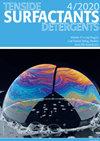N,N′-双(亚水杨基)-硫代羧酰肼-TritonX-100胶束体系浊点萃取法从浓氯化盐水介质中绿色去除低和高水平的Cu(II)和Cr(III)阳离子
IF 1.2
4区 工程技术
Q4 CHEMISTRY, APPLIED
引用次数: 0
摘要
摘要在这项工作中,我们用低浓度和高浓度的Cu(II)和Cr(III)进行了浊点提取,这两种特别有毒的金属污染物已被证明对人类健康和环境有不利影响。在作为非离子表面活性剂的Triton X-100和作为螯合配体的N,N′-双(亚水杨基)-硫代碳酰肼的存在下,在浓氯化物介质中实现了金属离子的去除。希夫碱在均匀二甲基亚砜水和胶束Triton X-100水介质中的行为进行了初步研究。所得的酸常数值表明,萃取剂在胶束介质中比在纯水介质中酸性更强。Triton X-100记录的浊点温度受到氯化钠浓度、表面活性剂浓度和Schiff碱配体的显著影响。在优化的实验条件下,Cu(II)的定量提取和最大提取率为74 % Cr(III)的含量。金属浓度从10−3降低 摩尔 L−1至10−6 摩尔 L−1导致温度降低了10 °C,接触时间从10缩短 h到3 h。本文章由计算机程序翻译,如有差异,请以英文原文为准。
Green removal of low and high levels of Cu(II) and Cr(III) cations from concentrated saline chloride medium achieved by a mixture of N,N′-bis(salicylidene)-thiocarbohydrazide-TritonX-100 micellar system via cloud point extraction process
Abstract In this work, we performed the cloud point extraction with low and high concentrations of Cu(II) and Cr(III), two particularly toxic metallic pollutants, that have been shown to have adverse effects on human health and the environment. Removal of the metal ions was achieved in the presence of Triton X-100 as a non-ionic surfactant and N,N′-bis(salicylidene)-thiocarbohydrazide as a chelating ligand in concentrated chloride medium. The behavior of the Schiff base was initially investigated in homogeneous DMSO-water and micellar Triton X-100-water media. The obtained values of the acid constants show that the extractant is more acidic in micellar media than in pure aqueous medium. The recorded cloud point temperatures of Triton X-100 are significantly impacted by the sodium chloride concentration, the surfactant concentration, and the Schiff base ligand. Under the optimised experimental conditions, a quantitative extraction of Cu(II) and a maximum extraction rate of 74 % of Cr(III) were obtained. The reduction of the metal concentration from 10−3 mol L−1 to 10−6 mol L−1 resulted in a reduction of the temperature by 10 °C and a reduction of the contact time from 10 h to 3 h.
求助全文
通过发布文献求助,成功后即可免费获取论文全文。
去求助
来源期刊

Tenside Surfactants Detergents
工程技术-工程:化工
CiteScore
1.90
自引率
10.00%
发文量
57
审稿时长
3.8 months
期刊介绍:
Tenside Surfactants Detergents offers the most recent results of research and development in all fields of surfactant chemistry, such as: synthesis, analysis, physicochemical properties, new types of surfactants, progress in production processes, application-related problems and environmental behavior. Since 1964 Tenside Surfactants Detergents offers strictly peer-reviewed, high-quality articles by renowned specialists around the world.
 求助内容:
求助内容: 应助结果提醒方式:
应助结果提醒方式:


